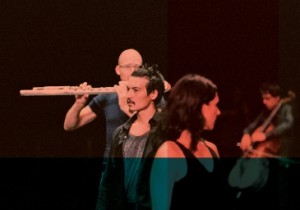 New York Times dance critic Anna Kisselgoff once described Anne Teresa de Keersmaeker as “a cross between Lucinda Childs and Pina Bausch … a choreographer who makes you think and feel at the same time.”
New York Times dance critic Anna Kisselgoff once described Anne Teresa de Keersmaeker as “a cross between Lucinda Childs and Pina Bausch … a choreographer who makes you think and feel at the same time.”
That was in 1986, the year that “Rosas danst Rosas” caused a sensation at the Brooklyn Academy of Music’s Next Wave Festival and won de Keersmaeker a Bessie award. Twenty five years later, it also created Beyoncé news. The singer was accused of plagiarizing “Rosas danst Rosas” in her 2011 music video “Countdown.” You couldn’t dream up a stranger artistic juxtaposition: American pop royalty and European modern dance minimalism.

“Rosas danst Rosas” is one of four de Keersmaeker works that the influential Belgian choreographer and her company Rosas are bringing to UCLA’s Royce Hall Nov 10-14. It is a rare event –two works from the 1980s and two more recent.
 The engagement kicks off with “Fase, Four Movements to the Music of Steve Reich” (1982) on Nov 10. “Fase,” only her second attempt at choreography, created a stir in Europe and beyond. Expect abstract movement that is both mechanical and strangely affecting. Keersmaeker herself will perform.
The engagement kicks off with “Fase, Four Movements to the Music of Steve Reich” (1982) on Nov 10. “Fase,” only her second attempt at choreography, created a stir in Europe and beyond. Expect abstract movement that is both mechanical and strangely affecting. Keersmaeker herself will perform.
On Nov 11, the company presents “Rosas danst Rosas” (1983), which features four women in straight-backed chairs executing endlessly repetitive movements that morph into a series of concrete emotional narratives. The music, by Thierry De Mey and Peter Vermeersch, was created simultaneously with the work and in interaction with the choreography.
 “Verklärte Nacht” (“Transfigured Night”) is a 1995 narrative work set to the Arnold Schoenberg score of the same title. Based on a poem by Richard Dehmel, the duet tells the story of a woman who confesses to the man she loves that she is pregnant with the child of another man. CAP-UCLA’s press release describes this one as “a shameless romantic love story.” That’s Nov 13.
“Verklärte Nacht” (“Transfigured Night”) is a 1995 narrative work set to the Arnold Schoenberg score of the same title. Based on a poem by Richard Dehmel, the duet tells the story of a woman who confesses to the man she loves that she is pregnant with the child of another man. CAP-UCLA’s press release describes this one as “a shameless romantic love story.” That’s Nov 13.
 Closing out the week, on Nov 14, is a 2013 work that reveals de Keersmaeker’s passion for intertwining sound and movement. In “Vortex Temporum featuring Ictus” both the dancers and the musicians (performing Gerard Grisey’s fugue-like score) travel the stage in a vortex of swinging circles. De Keersmaeker describes it in terms of time.
Closing out the week, on Nov 14, is a 2013 work that reveals de Keersmaeker’s passion for intertwining sound and movement. In “Vortex Temporum featuring Ictus” both the dancers and the musicians (performing Gerard Grisey’s fugue-like score) travel the stage in a vortex of swinging circles. De Keersmaeker describes it in terms of time.
“That which we call ‘now’ is, in fact, a permanent tipping point; a balancing act between memory and anticipation, leaning back and forth between the ghost image of the past and a desire towards the future.”
You could think about that as you watch – or just go with the flow.
Gillian Anne Renault has written about dance for the Los Angeles Daily News, Herald Examiner and artsATL in Atlanta.
Rosas: Then & Now | Anne Teresa De Keersmaeker & Company Rosas | Nov 10 – 14
